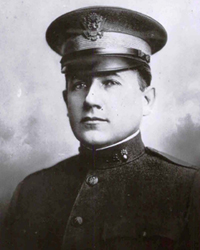Colonel
Leroy T. Hillman
 Col.Hillman was commissioned into the Artillery Corps in 1900 upon his
graduation from the US Military Academy. His assignments in Artillery placed him at Coast Artillery bases
where there have always been close connections between artillery units and the Ordnance Department. He was
involved in the production of artillery tubes at Watervliet and carriages at Rock Island. He was also
introduced to small arms production when he arrived at Rock Island Arsenal soon after the opening of the
M1903 Springfield line.
Col.Hillman was commissioned into the Artillery Corps in 1900 upon his
graduation from the US Military Academy. His assignments in Artillery placed him at Coast Artillery bases
where there have always been close connections between artillery units and the Ordnance Department. He was
involved in the production of artillery tubes at Watervliet and carriages at Rock Island. He was also
introduced to small arms production when he arrived at Rock Island Arsenal soon after the opening of the
M1903 Springfield line.
After returning to Artillery long enough to command a battery, Hillman returned to Ordnance duty and refined his skills through a variety of inspector and acceptance positions as well as the inspection and training of Ordnance and Artillery units.
It was after he was assigned to the Office of the Chief of Ordnance in July 1909 that Hillman that Hillman began to make major contributions to the Ordnance Corps. Hillman assisted with the development of a new carriage for the 3 inch field gun and submitted a patent application for an improved bolt and extraction lug for single shot bolt action rifles, such as the M1903 Springfield.
Later in 1916, Hillman was sent to Europe on a special mission from the Chief of Ordnance to analyze French and British artillery and small arms use in the war against Germany. Hillman was granted power to purchase drawings and specifications for artillery. With this one mission alone, Hillman was able to bring the Ordnance Corps up to modern standards on artillery and drove the US Army into the age of hydro-pneumatic recoil systems.
On the day that the US declared its entry into WWI, Hillman was meeting with the French General Staff who shared with him their insight into the most effective machine guns for war on the Western Front. While the US ordnance establishment was still enamored with water cooled heavy machine guns, Hillman passed back his recommendation that the Browning air cooled models be considered. This recommendation allowed the Ordnance Corps to adopt the Browning Automatic Rifle (BAR) which remained in use after the Korean War.
Hillman was next assigned to command Rock Island Arsenal. Hillman oversaw more than the manufacture of artillery during his tenure at Rock Island. While in command, the volume of business was the largest that has ever been transacted at the arsenal. This was also the period of the largest construction at the arsenal since the original construction period. In 1918, Rock Island Arsenal peaked at over 13,000 employees after a prewar base of only 1300. Hillman gave particular emphasis to employee quality of life and the relationship between management and employees.
Immediately following the November 1918 armistice, Col.Hillman was give one last assignment with a long lasting impact on the Ordnance Corps. Hillman was a principal member of a board of officers charged with recommending which Ordnance plants and arsenals would be retained, and if retained, the recommended area of expertise. Board recommendations clarified the role of the arsenals in relation to civilian industry and its recommendations established the civil military relationship that created the ability to surge and meet World War II requirements and which in many regards, remains in place today.
Immediately upon returning from his work on the facilities and expertise board, Col.Hillman was stricken with pneumonia and died a victim of the global influenza epidemic of 1918. With his death the Ordnance Corps lost an experienced and trusted officer who would have led Ordnance through the fiscally and doctrinally dark period of the inter war years.